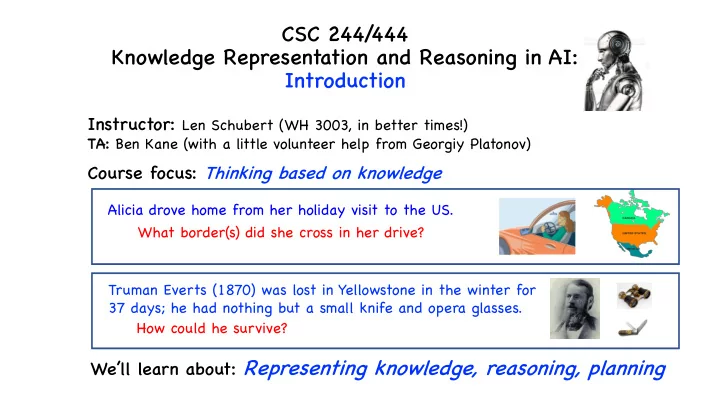

CSC 244/ 444 Knowledge Representation and Reasoning in AI: Introduction Instructor: Len Schubert (WH 3003, in better times!) TA TA: Ben Kane (with a little volunteer help from Georgiy Platonov) Course focus: Thinking based on knowledge Alicia drove home from her holiday visit to the US. What border(s) did she cross in her drive? Truman Everts (1870) was lost in Yellowstone in the winter for 37 days; he had nothing but a small knife and opera glasses. How could he survive? We’ll learn about: Representing knowledge, reasoning, planning
Course goals and logistics Please see LKS’ s course web page at https:/ /www.cs.rochester.edu/u/schubert/ 444/ Check out the links, as well … You should understand Course goals: methods of representing factual knowledge, using it for inference • and planning; readiness for KR&R research; basics in symbolic programming Requirements • Text (for 444), materials • Resources for learning Lisp • Schedule, lecture-by-lecture (and % weights) • Supplementary readings (Steven Pinker – intelligence; Asilomar AI principles – • beneficial AI; Paul Kennedy – Malthus redux; AI & Life in 2030 – what (not) to expect, how to proceed; Kai-Fu Lee –the real threat of AI)
“KR&R” in AI What are “logical” representations of knowledge? Formalization of language, enabling “mechanical” reasoning of various kinds; • “About-ness”: symbols & expressions refer to things/properties in the world • ( denotational semantics ); sentences (in language & logic) can be true or false; In general, we need to add specialized (symbolic & analog) representations; • Kinds of reasoning and planning: Deduction (but not exclusively!) • Abduction, induction (uncertain) • By analogy, and use of familiar patterns • Sources of knowledge Perception • Physical interaction • linguistic interaction, listening, reading; • great unsolved problem: (“few-shot”) learning via language (”KA bottleneck”)
Current status of AI, Future of AI Achievements Siri, Alexa, Google Assistant, Cortana, … • Jeopardy! (IBM’ s Watson), Wolfram|Alpha, • Deep Blue, Alpha Go/Zero • Rule-based systems for system design, banking, geological prospecting, • trouble-shooting, diagnosis, call routing, inventory maintenance, … DL (DNNs): Speech recognition, MT, image/video analysis/captioning, • text/response generation, GPT3 (450GB input, 175 billion parameters); but no real thinking, planning, reliable information. Outlook: Symbolic/DL integration?! • Self-driving vehicles, factory automation, construction, medical diagnosis/ • treatment, bank tellers, customer service, telemarketers, stock and bond traders, paralegals, radiologists, home assistants, elder care, … “Singularity”? (I.J. Good – “intelligence explosion”; Vernor Vinge) • Will we self-destruct first? (nuclear, climate, …) cf. Nick Bostrom re Fermi paradox • Richard Powers: We are “ pitched in a final footrace... between inventiveness and built-in insanity"
Common Lisp (some more comments) We can give lambda-functions a name using ‘defun’, e.g., (defun exp-ratio (x) (/ (exp x) (expt 2 x))) ; the ratio e x /2 x So, e.g., (exp-ratio 2) à 1.847264; (exp-ratio (sqrt 2) à 1.54335 Arguments of functions in Lisp can be “anything”: - atomic symbols like JOHN, CSC244, |lower-case-symbol|, |Lower Case Symbol|, … - numbers like 3, 3.14, 17 /5, … - strings like “Hello”, “Nice to meet you”, … - lists of any of the above, like (JOHN 3 “Hello”) - lists of atoms, lists, etc., like (CSC244 (JOHN 3 “Hello”) (|Intel| (JOHN 3))), … - arrays, created via make-array and accessed via aref - hash tables, created via make-hash-table and accessed via gethash - structures (with keys and values), created via defstruct, make-, & setf and accessed via <struc>-<keyword> functions Since data have the same (list structure) form as functions, we can write programs that create functions!
Common Lisp (some recursive list processing examples) ; Any list structure made up of atomic symbols can be viewed as a tree ; where only the terminal (leaf) nodes have labels -- namely the atoms ; in left-to-right order. ; (defun preorder-leaves (tree) ; Function for returning tree (list structure) nodes in pre-order (cond ((null tree) nil) ((atom tree) (list tree)) (t (append (preorder-leaves (car tree)) (preorder-leaves (cdr tree)))))) (setq tree '(A (B (C D) (E F)) ((G H) I))) (preorder-leaves tree); ===> (A B C D E F G H I)
Common Lisp (some recursive list processing examples) ; Any list structure made up of atomic symbols can alternatively be viewed ; as a tree where all nodes have labels, by regarding the fist element of ; each sublist as a node label, and the remaining elements (if any) as ; the children of the node. ; ; For a list structure where each list element at any level is either an ; atom or a list beginning with an atom, this can be viewed as a tree where ; all nodes have atomic labels. ; ; In this case, returning node labels in preorder just copies the tree! ; Check it: (defun preorder-nodes (tree) (cond ((null tree) nil) ((atom tree) (list tree)) (t (cons (car tree) (preorder-nodes (cdr tree)))))) BTW, in writing code, use logical alignment of successive line (even though Lisp doesn’ t care), and keep line lengths to about 75 – readability is important!
Common Lisp (some recursive list processing examples) ; Postorder is more interesting; i.e., we collect the postordered elements ; of the subtrees of a node before adding the root node (label). 'mapcar' can ; be used to postprocess all the subtrees (exclusive of the "root", i.e. first ; element) of a tree; we need to append the results (using (apply #'append ...)) ; and then add the root to the end: (defun postorder-nodes (tree) ; Function for returning tree nodes in post-order (cond ((null tree) nil) ((atom tree) (list tree)) (t (append (apply #'append (mapcar #'postorder-nodes (cdr tree))) (list (car tree)))) )); end of postorder-nodes (setq tree1 '(A (B (C D) (E F)) (G (H I J) K (L) ()))) (format t "~a" (postorder-nodes tree1)) ; ===> (D C F E B I J H K L G A) ; NB: The '()' (i.e., NIL) element is ignored
Recommend
More recommend